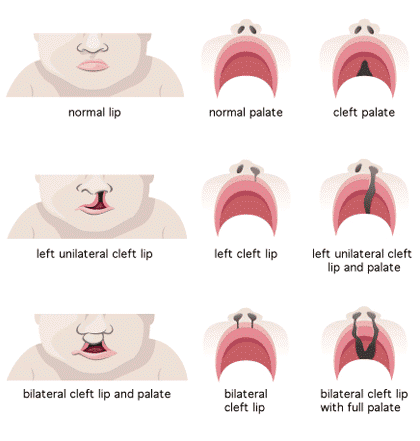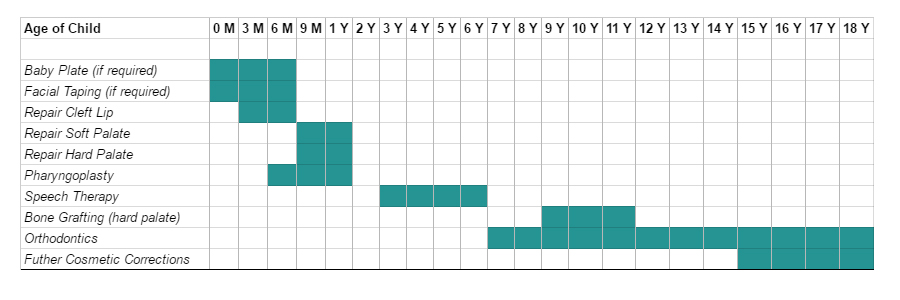You may be asking yourself, why does my child have a cleft palate, what causes a cleft pallet, and how common is it?
This page is designed to answer these questions, and provide some guidance on your journey.
You may be asking yourself, why does my child have a cleft palate, what causes a cleft pallet, and how common is it?
This page is designed to answer these questions, and provide some guidance on your journey.

A cleft can be a gap on one side (unilateral) or two gaps (bilateral). A cleft palate occurs where the cleft is in the roof of the mouth creating an opening into the nasal cavity. A cleft can be of the soft palate at the far back of the mouth, involve a missing or split in the uvula. Hard palate clefts involve the bony part of the roof of the mouth.
A cleft of the hard palate may be a split from the front or back toward the centre, or more rounded. Cleft lip may extend from the lip backwards into the mouth and affect the alveolar ridge where teeth belong later and into the hard palate. There are many combinations of cleft lip and cleft palate. A cleft which is completely on the inside of the mouth is very difficult to detect on ultrasound.
To the casual observer there is often nothing about the child’s outward appearance that would suggest a cleft palate. Children with a cleft lip experience quite an amazing transformation from their appearance as a newborn to when the first surgery occurs usually at 3-6 months of age.
Oftentimes when a cleft palate is diagnosed prior to birth, parents will not be sure how much of the palate is cleft, and therefore are unsure how to prepare for feeding. With the assistance nursing staff and midwives, your cleft newborn will receive nourishment from you by specialist feeding equipment designed to assist them in all the ways they need.
It is important to remember that babies with a cleft palate will not be able to produce adequate suction, and the effort of feeding will tire your baby quickly without assistance. Ask for a review with your lactation consultant as soon as you can after your baby’s arrival.
Breastfeeding a cleft baby is not impossible, and many women will report various experiences with feeding their newborns. Most babies with a cleft will need additional help to get the necessary amount of milk for nutrition, however, your child’s condition and feeding style will be assessed and specialist feeding equipment may be recommended by your doctors and therapists.
To further assist with feeding, we do offer our Newborn Hospital Support Bag, which includes an innovative & useful SpecialNeeds Feeder.
The first time feeding your cleft baby, you will want to seek assistance of nurses, midwives, and lactation consultants. Learning about the experiences of others can also be very useful and comforting, however as always, check your source is trustworthy and if you have any questions or concerns, consult your health care professional such as your GP or Speech Therapist.

A Cleft Clinic is where all consultants and surgeons you’ll be working with, will be in one room to talk about the treatment plan for your child, which allows all the surgeons to talk to you about what is needed, and work together to give the very best outcome for your child.
After the birth of your child, the plastic surgeon will be one of the first specialist you meet as they have the most influence on your child’s treatment plan. Each of the plastic surgeons have undergone specialist training in cleft lip repairs, palate repair, bone graft, jaw realignment and other re constructive and cosmetic surgeries.
ENT’s look after everything related to the ear, nose and throat. Cleft children will have regular hearing tests done by audiology to ensure their child hearing is where it needs to be. A common problem for all children can be the advent of “glue ear”. To fix this problem “grommets” are surgically implanted to help the ear do what it should. Quite ofter the ENT specialist will put in grommets during the lip or palate operation. The huge advantage of this is that the child does not need to undergo another separate surgery.
The orthodontist is initially seen soon after the birth for a baby plate or taping in preparation for lip repair surgery. These technique helps to give a better outcome when lip repair surgery occurs. Once the lip repair surgery has been completed you will generally only have check ups with the orthodontist but nothing major until around the time of your child’s bone graft. A bone graft is experienced by children with a cleft palate as there is a gap in the gum lining.
Surprisingly this is the next specialist you will see on your journey. As part of their university degree is the anatomy and in particular the functions of the mouth. Their knowledge is extensive and valuable. Speech are able to assist with all feeding related problems you might experience in the early days. Once all the initial issues have been rectified families they will generally be seen again around the child’s first birthday to see if any speaking issues are prevalent. Cleft children may or may not experience delayed speech related issues.
Many factors ultimately may be the cause for this which you won’t know until the time comes. Even the same type of clefts vary in degrees and therefore treatments.
To assist affected families, the Australian Government issues incentives and concessions to help cleft affected families. However, certain conditions apply, which outlines that the patient must:
You can also apply for a health care card under the carers allowance. Apply as a carer, and while you will likely be told that you were unsuccessful in getting payments, your cleft child will still receive a health care card. However, you will need to get your GP to fill in part of the form. Click here for more information on the health care card.
For more information on the incentive scheme and what entitlements are granted, visit the Australian Government information page.